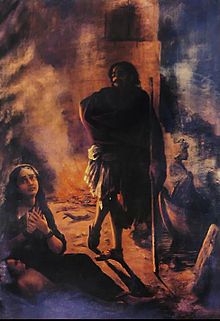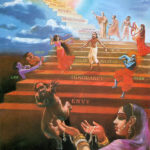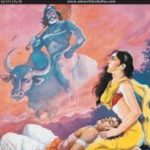Readers may recall our Post last year on Rta vs Rna. In it, we explained why Rna is necessarily subordinate to Dharma, and that the proper schema was in fact Satya then Rta then Dharma.
However, because we live in an era where knowledge itself is no longer seen as sacred but as a means of emolument, there are some fraudacharyas who are imputing wrong meaning into traditional definitions…partially out of their ignorance, but partially out of malevolence. Because their attempts to force Rna as somehow central to the Dharmic schema have been exposed, and realising they have left something out, they have tried to circumvent by saying everything is Sat. Everything is Sat, and Satya does express Rta. But Rta itself is the motivation for Dharma, not Rna. Rna is not the core of Sanatana Dharma: Satya, Rta, and Dharma are. Rna uber alles is the foundation for slavery—precisely what videshi slaves want.
This is because they have sold themselves out, they are privately paying off their own personal Rna by selling off Satya. Rna is below Dharma. Here is the correct schema:
Satya→Rta→Dharma→Rna
It is important to not only understand the distinctions between the four, but also their order of derivation. 
These Rnas come in many forms: Daiva-Rna, Rishi-Rna, Pitr-rna. Those are the traditional tri-rnas, the Vedic rnas that all must pay to the Devas, to the Rishis & Gurus, and to our Ancestors. After paying them, moksha is then possible. These are traditionally paid by yagna, by vedic study, and by progeny. [2, 416] But there are also other rnas. Matr-rna, Mitr-rna, and the most dominating one, Desa-rna. One is a rni (debtor) to his Mathru-bhoomi too. So how to determine which comes first? After all, is not Daiva above Desa? Is not Mathru above Mitra? Is not spiritual debt above monetary debt?
It is precisely because material rna can be easily conflated with spirtual rna, that we must repay Rna through the guidance of Dharma. It is precisely that Dharma is the guide for Rna and not the other way around that definitions matter. And it is precisely because some murkhapanditas prize material heaven above moksha that they continually ignore Desa-rna and Desa-Dharma, to the detriment of their countrymen, whom they betray. This is what happens to those who prize knowledge above wisdom…they end up neither breathing nor living & drag everyone else down with them.

Saying that Rna creates Dharma is like saying Vedas came from Man. Real Brahmanas know this to be otherwise. Just as the Vedas are Apaurusheya and were given to man from by God, so to does Dharma determine Rna, and specifically, which Rna should be paid when, or even be paid at all. Those in thrall to foreign funders naturally celebrate Rna—for they have assumed a lifetime and multi-life debt.
It is for this reason our Civilization is one of Truth not Debt (like some debt-driven societies). It is for this reason India’s national motto is Satyameva Jayate not Rnameva Jayate. It is Satya-Harischandra who is lauded not Mitr-rni Karna. It is love of Satya that constructs the order Rta and recognising the need for its preservation that creates Dharma. A society motivated by Rna is one first collapsed into chaos then caught in slavery.
The people who advocate Rna being the driver of Dharma are those who sold their souls and wish for you to the do the same.
https://youtu.be/iDbrX91FxE4?t=8m15s
Rna is used to buy the souls of Men, as Duryodhana bought Karna’s with Anga
He may be called “Daanveer Karan”, but his Daana, his Generosity, his liberality were all misplaced. Generosity to sinners is not generosity, it is signing one’s own death warrant, which is what Karna did when he gave everything, even his life, to pay off his debt to Duryodhana. His noble sentiment in sacrificing everything for the one person who stood by him is a noble one, but also a selfish one. Noble sentiments too can be selfish and misguided. Bhishma’s noble sentiment in taking his pratignya (oath) is the classic case.
We may all praise Bhishma for accepting the terrible oath of celibacy, despite being a royal prince, but he nevertheless violated Dharma and Rta by denying Hastinapura of a great king like himself. See how it suffered instability and uncertainty from the days of Chitrangada and Vichitraveerya on. This is the price of Rna and Moha. Desire to chase fame through sacrifice or to surrender to sentiment is also selfish…Noble, but misguided and harmful to society. To pay his personal debt, Karna was prepared to preside over Draupadi’s Vastraharan (attempted disrobing) and the unjust killing of Abhimanyu. What right does he (and those like him) have to lecture on Dharma?
https://www.youtube.com/watch?v=0QuKTBkGC_Y
Yudhisthira, on the other hand, was the opposite. He followed Truth to an extreme in the desire to be Satya-harishchandra, that he failed to prioritise his Dharma to his wife. It was a selfless mistake (he gained only shame and reprobation from this episode, not fame like Karna on the Kurukshetra), but a stupid mistake. He forgot that Harishchandra was in the beginning of the Treta Yuga (almost the Satya Yuga), while Yudhisthira was in the Dvapara (and that too, the very end). As the Yugas pass, people become more corrupt and sinful, and Dharma can no longer be so pristine, let alone naive. Yudhisthira was a king, and could not afford the luxury of being naive. When kings and politicians are naive, their prajas suffer.
When Satya-harishchandra honoured his promise to pay off his rna, his wife’s honour was not violated, but see what happened when Yudhisthira did the same thing. This is why the Panchatantra and Niti becomes important. In the present time, one must use viveka (distinguishment) to distinguish between right and wrong, wise and foolish, real and fake. Remember, a true Guru will never seek to confuse or confound, exploit or enslave, but will only seek to set you free, first from the torment of the senses, then from all Rnas.

Science has no authority over our Vedic Tradition. Only our trained Bharatiya Acharyas do. Those who are rooted in the land for millennia, understand its traditions the best.
Above all, remember, it was Sri Krishna himself who tried to educate Karna that Rna is used to buy the souls of men. It is fine to fulfill Rna for fruitive rewards, but only if it is not in conflict with Dharma, Rta, and Satya. This is the eternal way.
Bhagavad Gita 2:42-43
yam imam puspitam vacam
pravadanty avipascitah
veda-vada-ratah partha
nanyad astiti vadinah
kamatmanah svarga-para
janma-karma-phala-pradam
kriya-visesa-bahulam
bhogaisvarya-gatim prati ||
Men of small knowledge are very much attached to the flowery words of the Vedas, which recommend various fruitive activities for elevation to heavenly planets, resultant good birth, power, and so forth. Being desirous of sense gratification and opulent life, they say that there is nothing more than this.
There are of course some fashionable modernistas with superficial knowledge who use this to then say there is no point to ritual. But this is also false. Between Hippies without Obligations and material Ritualists without Compassion, is the happy middle of responsible and Dharmic living. Ritual gives us structure to life, but philosophical knowledge (jnana) and worship (bhakti) give us meaning in life. Ritual does have its place, as does the karma-kanda to those eligible for it. As the saying goes, “the same key that takes you to heaven can take you to hell“. Ravana used it to go to hell. Our Rishis like Vishvamitra used it to, forget going to heaven, but actually created an alternate material heaven for Trisanku. Such is the power of the Veda. But the wisest use the Veda to attain liberation (moksha) from the bondage of rebirth. They recognise it is possible through the structure of the Purushartha to neither lead a depressing and dour life without the rang (colour) of kama (pleasure) nor the life of the irresponsible hedonist, concerned only for his or her own pleasure. The Puranas give us many stories of those who live a happy, content, but responsible life and attain moksha in the process. The Satyanarayana Vratha also facilitates this process for those not eligible to do Vedic yagna.
Those who study the Veda have to take utmost precaution, not only when chanting mantras, but also in understanding the purpose for which they perform ritual. That is why the traditional Brahmana was traditionally respected…it is a very difficult, disciplined life to lead.
The ancient Rishis of yore would perform yagna for the benefit of all mankind. Further, the stringent life of traditional brahmanas as prescribed in the Dharmasastra, ensures a level of discipline that helps individuals transcend the cravings of the senses so that they may become fit for philosophical knowledge. Thus, Lord Krishna is not diminishing the importance of the Vedas, he is only putting them into the correct context. The Vedas are ever in consonance with Dharma. For those who pursue a certain way of life, Vedic ritual is eminently good—Krishna is only advising them to use their knowledge responsibly.
In any event, having contextualised the Rnas stipulated in the Vedic tradition, it is important to understand the need to live a life of balance. Because the Kali Yuga is such a terrible time, full of pleasurable but sinful distractions and many fraudacharyas (there are still some real Acharyas though, so find one), mere japa (chanting of God’s name) is sufficient for the average person. Rather than fighting the impulses causing sense-craving, the Saints say channel those impulses into good and productive efforts. Don’t fight the energy with a dam, but like an irrigation work, channel it to Artha, Moksha, and Kama in the right proportions through Dharma. Do your work during the day, complete your rituals/prayers in the evening, enjoy pleasure in the night. This is the traditional division for the parts of the day. In this way it is possible to do your Dharma to society, fulfill your rna to your obligators, and enjoy the pleasure of life. The happiest life is the balanced life.
The Purusharthas stipulate a life of balance. Artha, Kama, and Moksha are all important, but it is Dharma that guides all three. One cannot point to pitr-rna or daiva-rna or rishi-rna or mitr-rna to explain why their treachery is justified, as they wish to attain svarga (material heaven of pleasures) or moksha (ultimate liberation). Betrayal of one’s country is not justified. Vibhishana made every effort to bring Ravana to the right path, despite being Ravana’s rni. It was only to save Lanka from annihilation, and only because Sri Rama was the incarnation of Dharma, that Vibhishana went over to the other side. Thus, he is the exception and not the rule.
Therefore, rather than mocking the Veda (which one can only understand through proper Adhyapana, meaning “instruction”), respect those who have chosen the arduous path, and do your own duty. If you are upset at mean-spirited or hypocritical priests, find some sincere priests—there are actually many suffering from dire poverty and absence of benefactors. You may not feel Rna to those leading a traditional life, but give support out of a sense of Dharma to society, and its vulnerable sections. Even if you are agnostic, and don’t believe in ritual knowledge, at least give support to those who preserve our tradition and protect it from materialist foreigners misrepresenting our culture & history.
Here was one such traditional Pandit who deserves our respect for preserving our historical memory. We are all rnis to him.

Despite this Rna, preservation of Dharma knows only Rta, which must be preserved as it is the expression of Satya. By upholding Rta, all are benefited. By obsessing over Rna, only 1 or a few are benefited. Pandit Chelam may have had rnas to his foreign instructors of English and other subjects, but it was through his prioritisation of Dharma, Rta, and ultimately Satya, that he published 24 books documenting our true history. That is why Satya is the highest, most absolute concept. Dharma may bend the transactional everyday truth (“Ashwattama attaha“) to preserve this absolute Truth. But it is Satya which is absolute.
The order of hierarchy is Satya, Rta, Dharma, then Rna. Because if people don’t know which Rna to pay when, they end up like Karna…who chose his Rna to Duryodhana. Pitr-rna, Deva-rna are all to be paid when the common Dharma isn’t violated. A world of competing Rnas leads to chaos, in which each individual focuses on his (perceived rna) rather than than Saamaanya Dharma. That is why Rna is a secondary priority. Dharma is the first.
Opponents may argue that by prioritising Rna as the roots, the tree of Dharma will flourish. But the rebuttal is “yes, one tree will flourish, to the detriment of others“. The tree of Dharma in this case is the tree of Sva-Dharma (the personal Dharma). If you greedily prioritise your own Rnas, your own roots, other will not have water to be able to pay off theirs, and the other trees and plants die. A Dharma-driven society ensures the whole community flourishes. A Rna-driven society, is a selfish society, and is not “sustainable”.
Dharma is the righteous upholding of the Cosmic Order Rta which is expressed by the Absolute Truth Satya. Rna only ever comes after.
https://youtu.be/9lKfgTuJc-0?t=2363
References:
- Bhagavad Gita. http://asitis.com/2/42-43.html
- Kane, P.V. History of Dharmasastra. Vol.3.P.2. Poona: Bhandarkar Oriental Research Institute. 1973.
- Suresvaracarya, Shoun Hino & K.P. Jog. Sureśvara’s Vārtika on Saptānna Brāhmaṇa.Delhi: MLBD.1995.p.94



![[Reprint Post] Prema is not Moha](https://indicportal.org/wp-content/uploads/2015/12/gallery_1_42_1914401-150x150.jpg)